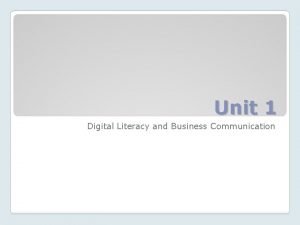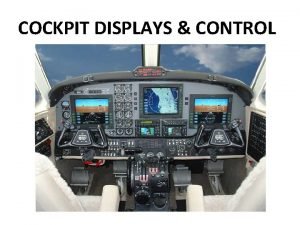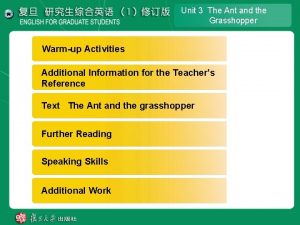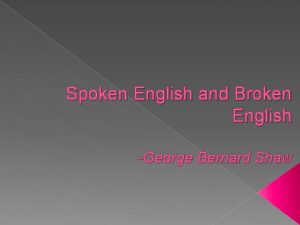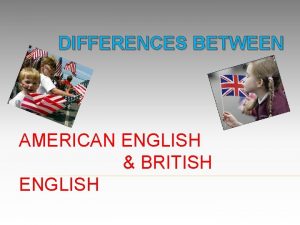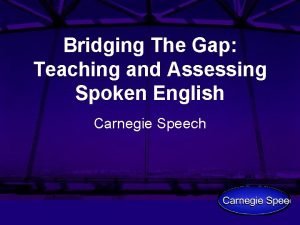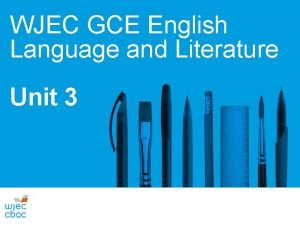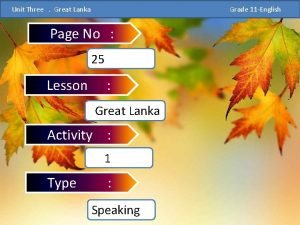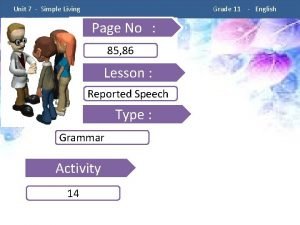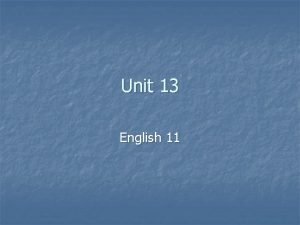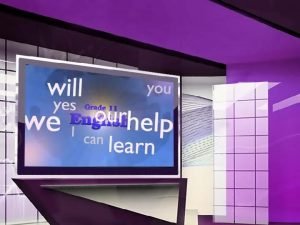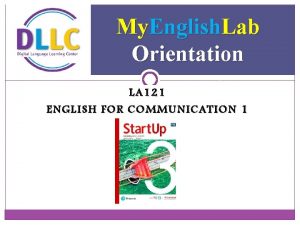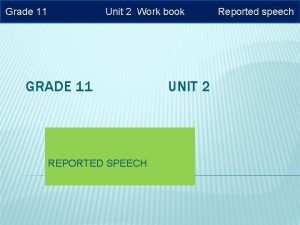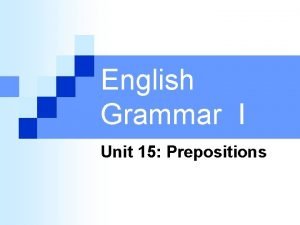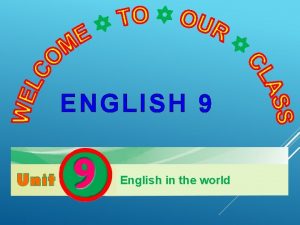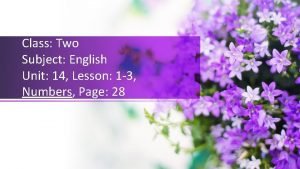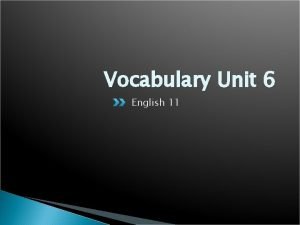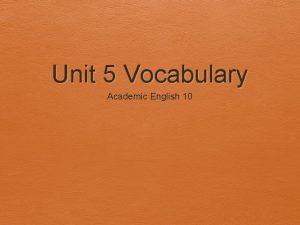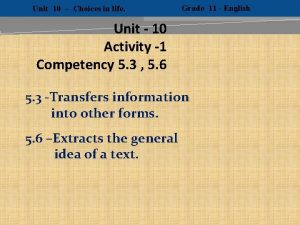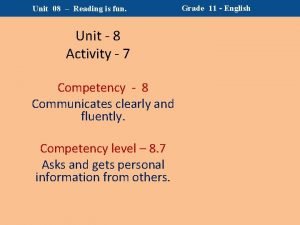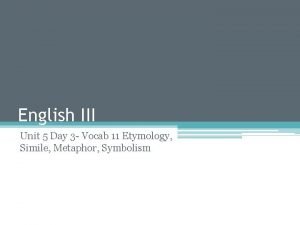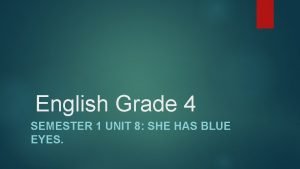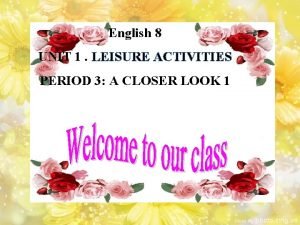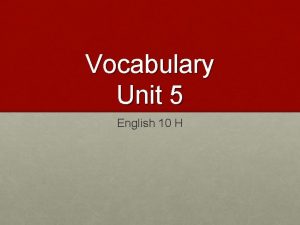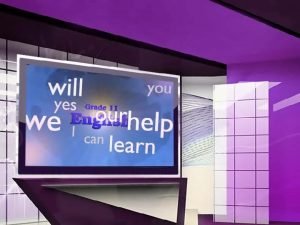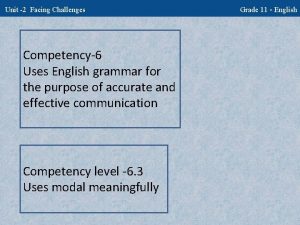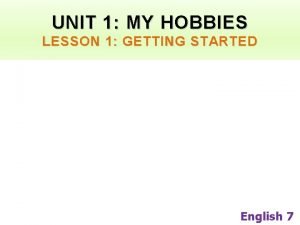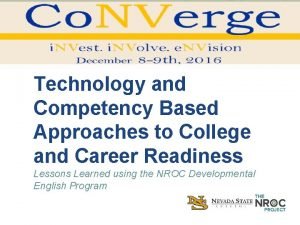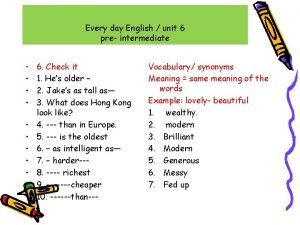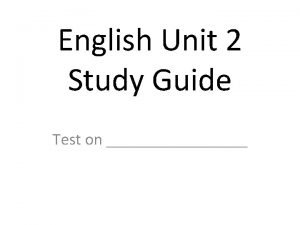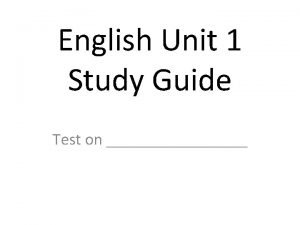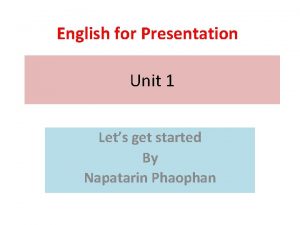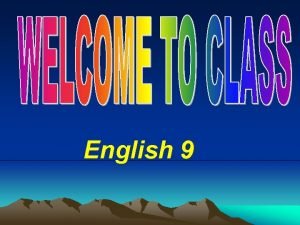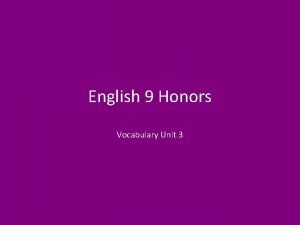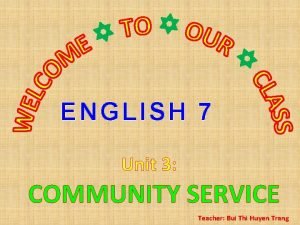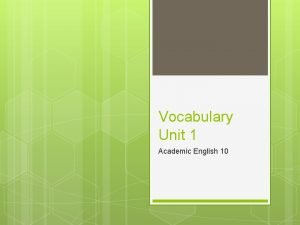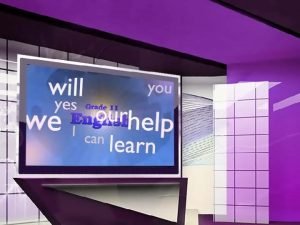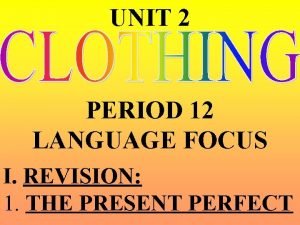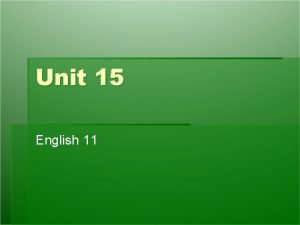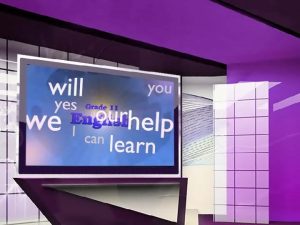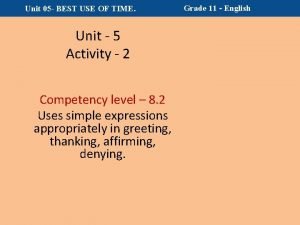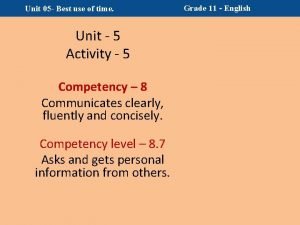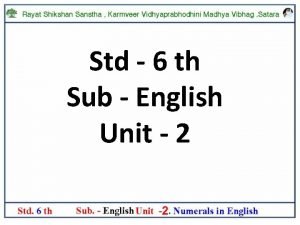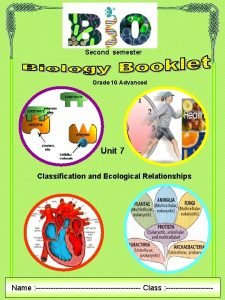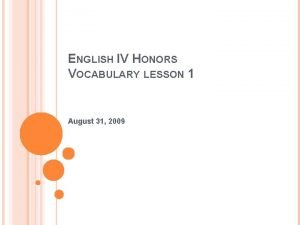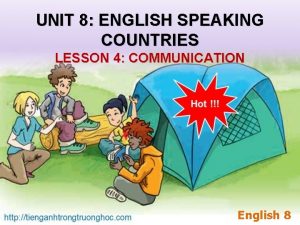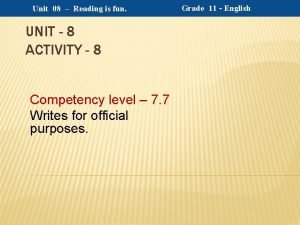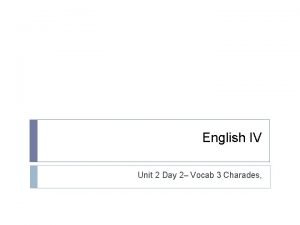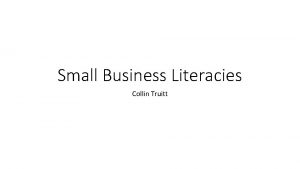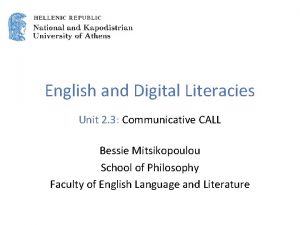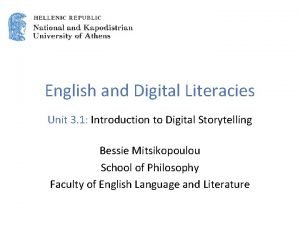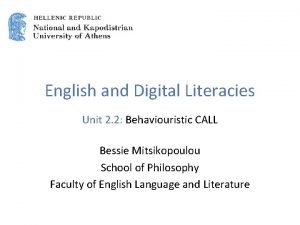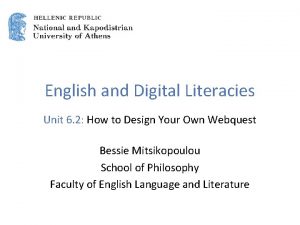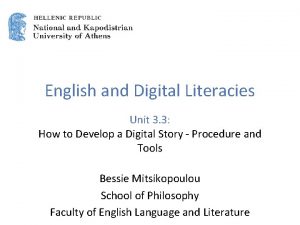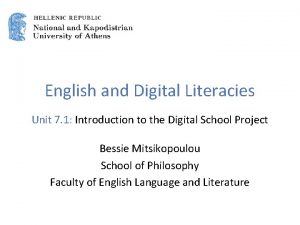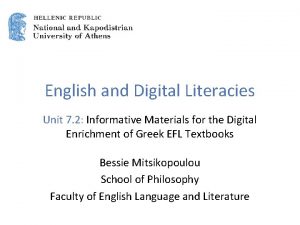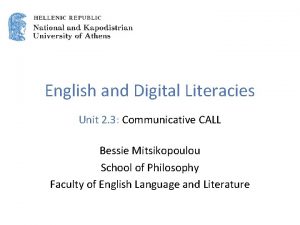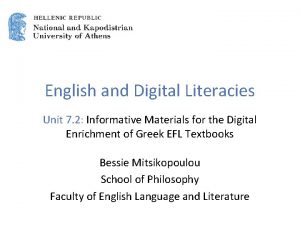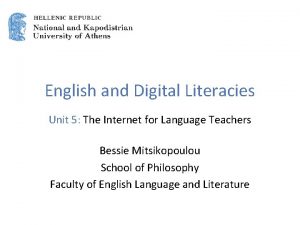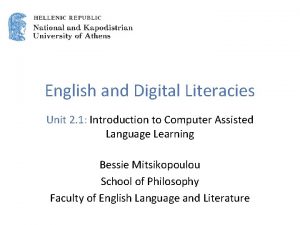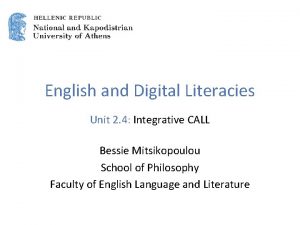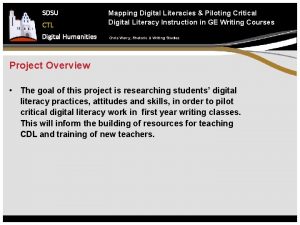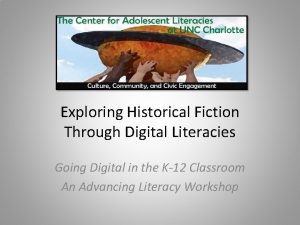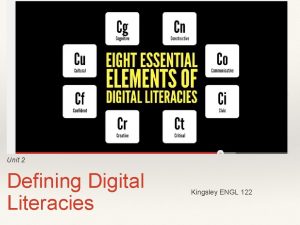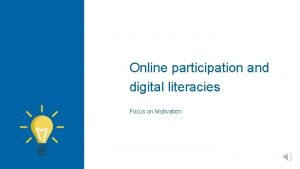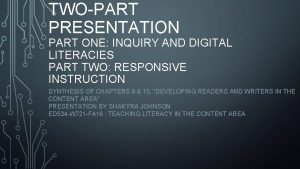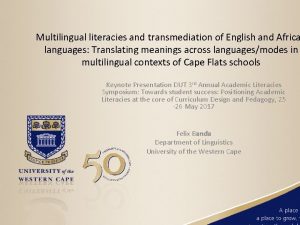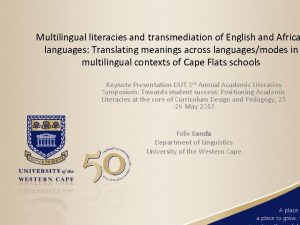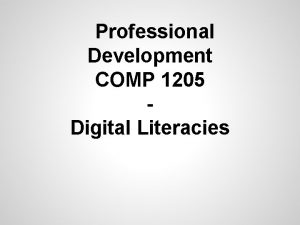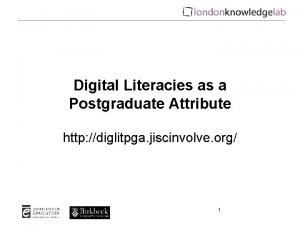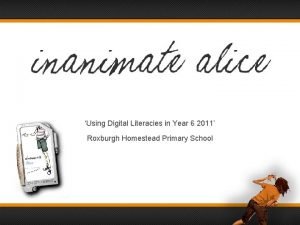English and Digital Literacies Unit 1 English and





![Flashcards [2] English and Digital Literacies - Why together? 6 Flashcards [2] English and Digital Literacies - Why together? 6](https://slidetodoc.com/presentation_image_h2/98e4c0d7b1ebfcd93692bf6fe50a3137/image-6.jpg)
![Posters Meaning is given through the visual mode [3] English and Digital Literacies - Posters Meaning is given through the visual mode [3] English and Digital Literacies -](https://slidetodoc.com/presentation_image_h2/98e4c0d7b1ebfcd93692bf6fe50a3137/image-7.jpg)
![Visual texts in a textbook [4] English and Digital Literacies - Why together? 8 Visual texts in a textbook [4] English and Digital Literacies - Why together? 8](https://slidetodoc.com/presentation_image_h2/98e4c0d7b1ebfcd93692bf6fe50a3137/image-8.jpg)


![Picture books (1/2) A picture book that relies on visual images only. [6] English Picture books (1/2) A picture book that relies on visual images only. [6] English](https://slidetodoc.com/presentation_image_h2/98e4c0d7b1ebfcd93692bf6fe50a3137/image-11.jpg)
![Picture books (2/2) A picture book that includes both textual and visual elements. [7] Picture books (2/2) A picture book that includes both textual and visual elements. [7]](https://slidetodoc.com/presentation_image_h2/98e4c0d7b1ebfcd93692bf6fe50a3137/image-12.jpg)
![Online interactive children’s book (1/2) [8] English and Digital Literacies - Why together? 13 Online interactive children’s book (1/2) [8] English and Digital Literacies - Why together? 13](https://slidetodoc.com/presentation_image_h2/98e4c0d7b1ebfcd93692bf6fe50a3137/image-13.jpg)

![Comic Strips [10] English and Digital Literacies - Why together? [11] 15 Comic Strips [10] English and Digital Literacies - Why together? [11] 15](https://slidetodoc.com/presentation_image_h2/98e4c0d7b1ebfcd93692bf6fe50a3137/image-15.jpg)
![Webpages [12] In a webpage elements such as sound effects, oral language, written language, Webpages [12] In a webpage elements such as sound effects, oral language, written language,](https://slidetodoc.com/presentation_image_h2/98e4c0d7b1ebfcd93692bf6fe50a3137/image-16.jpg)























![Από τον «αλφαβητισμό» [14] English and Digital Literacies - Why together? [15] 40 Από τον «αλφαβητισμό» [14] English and Digital Literacies - Why together? [15] 40](https://slidetodoc.com/presentation_image_h2/98e4c0d7b1ebfcd93692bf6fe50a3137/image-40.jpg)
![στην «εγγραματοσύνη» [16] English and Digital Literacies - Why together? 41 στην «εγγραματοσύνη» [16] English and Digital Literacies - Why together? 41](https://slidetodoc.com/presentation_image_h2/98e4c0d7b1ebfcd93692bf6fe50a3137/image-41.jpg)
![και στον «γραμματισμό» [17] English and Digital Literacies - Why together? [18] 42 και στον «γραμματισμό» [17] English and Digital Literacies - Why together? [18] 42](https://slidetodoc.com/presentation_image_h2/98e4c0d7b1ebfcd93692bf6fe50a3137/image-42.jpg)
![και στον «ψηφιακό γραμματισμό» [20] [19] [21] English and Digital Literacies - Why together? και στον «ψηφιακό γραμματισμό» [20] [19] [21] English and Digital Literacies - Why together?](https://slidetodoc.com/presentation_image_h2/98e4c0d7b1ebfcd93692bf6fe50a3137/image-43.jpg)

![From traditional schools [24] English and Digital Literacies - Why together? 45 From traditional schools [24] English and Digital Literacies - Why together? 45](https://slidetodoc.com/presentation_image_h2/98e4c0d7b1ebfcd93692bf6fe50a3137/image-45.jpg)
![To the school of the future [25] English and Digital Literacies - Why together? To the school of the future [25] English and Digital Literacies - Why together?](https://slidetodoc.com/presentation_image_h2/98e4c0d7b1ebfcd93692bf6fe50a3137/image-46.jpg)
![The school of the future (1/6) [26] This is a school today in Sweden: The school of the future (1/6) [26] This is a school today in Sweden:](https://slidetodoc.com/presentation_image_h2/98e4c0d7b1ebfcd93692bf6fe50a3137/image-47.jpg)

![The school of the future (3/6) [28] This school abandons completely the logic of The school of the future (3/6) [28] This school abandons completely the logic of](https://slidetodoc.com/presentation_image_h2/98e4c0d7b1ebfcd93692bf6fe50a3137/image-49.jpg)
![The school of the future (4/6) [29] The furniture is minimal and looks like The school of the future (4/6) [29] The furniture is minimal and looks like](https://slidetodoc.com/presentation_image_h2/98e4c0d7b1ebfcd93692bf6fe50a3137/image-50.jpg)
![The school of the future (5/6) [30] There are no grades and students learn The school of the future (5/6) [30] There are no grades and students learn](https://slidetodoc.com/presentation_image_h2/98e4c0d7b1ebfcd93692bf6fe50a3137/image-51.jpg)
![The school of the future (6/6) [31] Watch the video. English and Digital Literacies The school of the future (6/6) [31] Watch the video. English and Digital Literacies](https://slidetodoc.com/presentation_image_h2/98e4c0d7b1ebfcd93692bf6fe50a3137/image-52.jpg)



![Sugata Mitra & The Hole In the Wall [33] Watch the video. English and Sugata Mitra & The Hole In the Wall [33] Watch the video. English and](https://slidetodoc.com/presentation_image_h2/98e4c0d7b1ebfcd93692bf6fe50a3137/image-56.jpg)


















- Slides: 74

English and Digital Literacies Unit 1: English and Digital Literacies - Why together? Bessie Mitsikopoulou School of Philosophy Faculty of English Language and Literature

Understanding of the Basic Concepts 1. The notions of: • Literacy and Literacies, • English Literacy, • Digital Literacy. 2. The Greek context. English and Digital Literacies - Why together? [1] 2

The Notion of Literacy The traditional view of literacy focuses on the four language skills: • Reading, • Writing, • Speaking, • Listening. English and Digital Literacies - Why together? Receptive skills Productive skills Reading Writing Listening Speaking 3

From mono-modal to multi-modal texts • With the use of new technologies texts stopped being mono-modal and became multimodal. • Multimodal text: combination of two or more communication modes (for example, print, image and spoken text, as in film or computer presentations) • This powerpoint presentation is an example of a multimodal text. English and Digital Literacies - Why together? 4

Examples of visual texts
![Flashcards 2 English and Digital Literacies Why together 6 Flashcards [2] English and Digital Literacies - Why together? 6](https://slidetodoc.com/presentation_image_h2/98e4c0d7b1ebfcd93692bf6fe50a3137/image-6.jpg)
Flashcards [2] English and Digital Literacies - Why together? 6
![Posters Meaning is given through the visual mode 3 English and Digital Literacies Posters Meaning is given through the visual mode [3] English and Digital Literacies -](https://slidetodoc.com/presentation_image_h2/98e4c0d7b1ebfcd93692bf6fe50a3137/image-7.jpg)
Posters Meaning is given through the visual mode [3] English and Digital Literacies - Why together? 7
![Visual texts in a textbook 4 English and Digital Literacies Why together 8 Visual texts in a textbook [4] English and Digital Literacies - Why together? 8](https://slidetodoc.com/presentation_image_h2/98e4c0d7b1ebfcd93692bf6fe50a3137/image-8.jpg)
Visual texts in a textbook [4] English and Digital Literacies - Why together? 8

A shift in science textbooks Switch from visuals that support text explanations to text that supports visual explanations. “Graphics hold more meaning and are central to the meaning of modern texts. ” (Kress, et al. , 1998) English and Digital Literacies - Why together? [5] 9

Examples of multimodal texts
![Picture books 12 A picture book that relies on visual images only 6 English Picture books (1/2) A picture book that relies on visual images only. [6] English](https://slidetodoc.com/presentation_image_h2/98e4c0d7b1ebfcd93692bf6fe50a3137/image-11.jpg)
Picture books (1/2) A picture book that relies on visual images only. [6] English and Digital Literacies - Why together? 11
![Picture books 22 A picture book that includes both textual and visual elements 7 Picture books (2/2) A picture book that includes both textual and visual elements. [7]](https://slidetodoc.com/presentation_image_h2/98e4c0d7b1ebfcd93692bf6fe50a3137/image-12.jpg)
Picture books (2/2) A picture book that includes both textual and visual elements. [7] English and Digital Literacies - Why together? 12
![Online interactive childrens book 12 8 English and Digital Literacies Why together 13 Online interactive children’s book (1/2) [8] English and Digital Literacies - Why together? 13](https://slidetodoc.com/presentation_image_h2/98e4c0d7b1ebfcd93692bf6fe50a3137/image-13.jpg)
Online interactive children’s book (1/2) [8] English and Digital Literacies - Why together? 13

Online interactive children’s book (2/2) Interactive books combine: • still or moving pictures (visual), • video (visual), • narration (audio), • sound effects (audio), • music (audio), • written text. English and Digital Literacies - Why together? [9] 14
![Comic Strips 10 English and Digital Literacies Why together 11 15 Comic Strips [10] English and Digital Literacies - Why together? [11] 15](https://slidetodoc.com/presentation_image_h2/98e4c0d7b1ebfcd93692bf6fe50a3137/image-15.jpg)
Comic Strips [10] English and Digital Literacies - Why together? [11] 15
![Webpages 12 In a webpage elements such as sound effects oral language written language Webpages [12] In a webpage elements such as sound effects, oral language, written language,](https://slidetodoc.com/presentation_image_h2/98e4c0d7b1ebfcd93692bf6fe50a3137/image-16.jpg)
Webpages [12] In a webpage elements such as sound effects, oral language, written language, music and still or moving images are combined. English and Digital Literacies - Why together? 16

Live Performances In a live ballet performance gesture, music, and space are the main elements. Multimodal texts can be delivered via different media or technologies. They may be live, paper, or digital electronic. English and Digital Literacies - Why together? [13] 17

Move from Literacy to Literacies So, literacy is not a single thing, but a multiple and complex phenomenon. Consequently, there is not one literacy but different types of literacies. English and Digital Literacies - Why together? 18

Literacies Traditional Literacy: reading, writing, listening, speaking Literacies Visual Literacy: the ability to understand & produce visual images Digital Literacy: the ability to use digital technology and tools to locate and use information Information Literacy: the ability to find, evaluate and synthesize information Media Literacy: the ability to question, analyse, evaluate & create media messages Critical Literacy: the ability to question, challenge and evaluate the meanings of texts English and Digital Literacies - Why together? 19

New literacies (1/2) New technologies require new literacies to effectively exploit their potentials. These include technologies such as: • gaming software, • video technologies, • technologies that establish communities on the Internet, • search engines, • webpages, etc. English and Digital Literacies - Why together? 20

New literacies (2/2) We redefine literacy when we communicate on a chatboard, talk to one another using a video cam, or participate in virtual reality role-playing games. English and Digital Literacies - Why together? 21

The educators’ role (1/2) • Literacy is changing in a new media world (Kress, 2003). • By educating students to understand communicate through multimodal texts, teachers empower their students with the necessary tools to function effectively in increasingly media-varied environments. English and Digital Literacies - Why together? 22

The educators’ role (2/2) • We need to develop new educational practices that relate to children and young people’s out-of-school practices if the literacy curriculum is to be relevant and meaningful (Marsh and Millard, 2013). English and Digital Literacies - Why together? 23

New Ways of Reading

Reading print-based vs multimodal texts (1/2) Print-based texts Multimodal texts Principle mode: the words that ‘tell’ including discourse, register, vocabulary, linguistic patterns, grammar. Arrangement and layouts of chapters, paragraphs and sentence structure, typography. Principle mode: visual images that ‘show’ including layout, size, shape, colour, line, angle, position, perspective, screen, frames, icons, links, hyperlinks. Movement, sound, animation with graphics, video clips, voice over, write over. (Walsh, 2006: 35) English and Digital Literacies - Why together? 25

Reading Pathway Visual Imagery Reading print-based vs multimodal texts (2/2) Print-based texts Multimodal texts Verbal imagery: including description, images, symbolism, metaphor, simile, alliteration, poetic devices with words, sound patterns. Visual imagery and sound effects: use of colour, motifs, icons, repetion, with specific voice, music and sound effects. Mostly linear and sequential. Reader mostly follows. Non-sequential, nonlinear. Reader has more choice and opportunities to interact. (Walsh 2006: 35) English and Digital Literacies - Why together? 26

The Greek context In Greece, an important shift in language and literacy practices of adolescents that we can understand only if we take into account the global and local dimensions (Mitsikopoulou, 2007). English and Digital Literacies - Why together? 27

English and Digital literacies in Greece common ground (1/2) • English and ICT literacies are interwoven in the everyday practices of Greek adolescents. • Both employ a common rhetoric concerning their usefulness in the future lives of the young people. • Both count as ‘powerful’ resources or cultural capital, and are thus prioritised by Greek families. English and Digital Literacies - Why together? 28

English and Digital literacies in Greece common ground (2/2) • Both are viewed as resources which all literate people of the 21 st century should develop. • Both have an ‘outside’ dimension: they come from elsewhere, are imported and not selfinvented or indigenous. English and Digital Literacies - Why together? 29

What Greek parents say Quite often in the study, Greek parents refer to English and digital literacies together: “What our children need today is English and computers”. Embedded in this rhetoric is a naturalised assumption which acknowledges the development of English language resources as a precondition to develop ICT literacies (since ‘even the simplest words are in English’). English and Digital Literacies - Why together? 30

What Greek adolescents say the children reported that outside the classroom, they mainly use English on the Internet. They frequently acknowledge the benefits of English language skills for systematic use of ICT, as 14 -year-old Chara said: “How can you learn how to use a computer if you don’t know English? They are woven together, interrelated. ” “Learners do not only use the Internet to learn English but they also learn English to use the Internet” (Warschauer and Whittaker, 1997: 1) English and Digital Literacies - Why together? 31

Testimonials (1/2) “In the past when my English was not good enough I had difficulty using the computer. There are some signs which cannot be translated into Greek. . . for some instructions when I was trying to load a game, there were some buttons which I should. . . or some codes which I should type in English and when the program would tell me, ‘go there’, and it was in English, I would say, Upps! Where is this? ” (Mary, 15 years old) English and Digital Literacies - Why together? 32

Testimonials (2/2) “When I first started playing a strategy game and I came across a word I didn’t know in English, I saved the game and continued playing. As I played I could later understand what the game had asked me to do. If I did something I shouldn’t have done because I couldn’t understand what the program had asked me to do in English, I used to go back to the point I had saved my work and change what I had done, so that I didn’t have to start the game from the beginning. Other times, I could guess what I needed to do from the games’ short videos. ” (Angel, 14 years old) English and Digital Literacies - Why together? 33

The ‘power of literacy’ discourse in Greece (1/2) In the past (1950 -mid 1990 s), this discourse emphasized the importance of: • developing good literacy skills in the Greek language, • getting a university degree (as a means of social recognition). Recent changes due to globalization and developments in Europe have created new literacies of power in Greece. English and Digital Literacies - Why together? 34

The ‘power of literacy’ discourse in Greece (2/2) Today, this discourse emphasizes the importance of: • developing advanced knowledge of English, • developing ICT skills. Effects on education policies and out-of-school literacy practices. English and Digital Literacies - Why together? 35

Changes in education policies (1/2) Mid 1990 s: • the introduction of English language from the third grade, • the changing of curricula, including the incorporation of new teaching methodologies (Cross-Thematic Curriculum for Compulsory Education). English and Digital Literacies - Why together? 36

Changes in education policies (2/2) 2000 s: • the introduction of the State Certificate of Language Proficiency, • the development of new textbooks to be used in state schools, • the introduction of a second foreign language later in the primary school. English and Digital Literacies - Why together? 37

Recent changes in FL education policies 2010 s: • new common curriculum for all languages taught at schools, • the introduction of the English language from the first grade of primary education (the PEAP project), • the Digital School project (to enhance textbooks with digital content), • the preparation of the e-test of the State Certificate of Language Proficiency. English and Digital Literacies - Why together? 38

Towards a new era with new educational materials and resources
![Από τον αλφαβητισμό 14 English and Digital Literacies Why together 15 40 Από τον «αλφαβητισμό» [14] English and Digital Literacies - Why together? [15] 40](https://slidetodoc.com/presentation_image_h2/98e4c0d7b1ebfcd93692bf6fe50a3137/image-40.jpg)
Από τον «αλφαβητισμό» [14] English and Digital Literacies - Why together? [15] 40
![στην εγγραματοσύνη 16 English and Digital Literacies Why together 41 στην «εγγραματοσύνη» [16] English and Digital Literacies - Why together? 41](https://slidetodoc.com/presentation_image_h2/98e4c0d7b1ebfcd93692bf6fe50a3137/image-41.jpg)
στην «εγγραματοσύνη» [16] English and Digital Literacies - Why together? 41
![και στον γραμματισμό 17 English and Digital Literacies Why together 18 42 και στον «γραμματισμό» [17] English and Digital Literacies - Why together? [18] 42](https://slidetodoc.com/presentation_image_h2/98e4c0d7b1ebfcd93692bf6fe50a3137/image-42.jpg)
και στον «γραμματισμό» [17] English and Digital Literacies - Why together? [18] 42
![και στον ψηφιακό γραμματισμό 20 19 21 English and Digital Literacies Why together και στον «ψηφιακό γραμματισμό» [20] [19] [21] English and Digital Literacies - Why together?](https://slidetodoc.com/presentation_image_h2/98e4c0d7b1ebfcd93692bf6fe50a3137/image-43.jpg)
και στον «ψηφιακό γραμματισμό» [20] [19] [21] English and Digital Literacies - Why together? [22] [23] 43

New schools
![From traditional schools 24 English and Digital Literacies Why together 45 From traditional schools [24] English and Digital Literacies - Why together? 45](https://slidetodoc.com/presentation_image_h2/98e4c0d7b1ebfcd93692bf6fe50a3137/image-45.jpg)
From traditional schools [24] English and Digital Literacies - Why together? 45
![To the school of the future 25 English and Digital Literacies Why together To the school of the future [25] English and Digital Literacies - Why together?](https://slidetodoc.com/presentation_image_h2/98e4c0d7b1ebfcd93692bf6fe50a3137/image-46.jpg)
To the school of the future [25] English and Digital Literacies - Why together? 46
![The school of the future 16 26 This is a school today in Sweden The school of the future (1/6) [26] This is a school today in Sweden:](https://slidetodoc.com/presentation_image_h2/98e4c0d7b1ebfcd93692bf6fe50a3137/image-47.jpg)
The school of the future (1/6) [26] This is a school today in Sweden: it replaces the traditional classroom with an environment that enhances students’ creativity. English and Digital Literacies - Why together? 47

The school of the future (2/6) The design of the school has open spaces so that children can work independently in open places so that they can relax or go to the “village” in order to work in groups for projects. [27] English and Digital Literacies - Why together? 48
![The school of the future 36 28 This school abandons completely the logic of The school of the future (3/6) [28] This school abandons completely the logic of](https://slidetodoc.com/presentation_image_h2/98e4c0d7b1ebfcd93692bf6fe50a3137/image-49.jpg)
The school of the future (3/6) [28] This school abandons completely the logic of a single classroom with four walls and desks in rows. English and Digital Literacies - Why together? 49
![The school of the future 46 29 The furniture is minimal and looks like The school of the future (4/6) [29] The furniture is minimal and looks like](https://slidetodoc.com/presentation_image_h2/98e4c0d7b1ebfcd93692bf6fe50a3137/image-50.jpg)
The school of the future (4/6) [29] The furniture is minimal and looks like lines on a piece of paper, in order to trigger student creativity when they work in groups. English and Digital Literacies - Why together? 50
![The school of the future 56 30 There are no grades and students learn The school of the future (5/6) [30] There are no grades and students learn](https://slidetodoc.com/presentation_image_h2/98e4c0d7b1ebfcd93692bf6fe50a3137/image-51.jpg)
The school of the future (5/6) [30] There are no grades and students learn in groups, with other children who are not necessarily of the same age. English and Digital Literacies - Why together? 51
![The school of the future 66 31 Watch the video English and Digital Literacies The school of the future (6/6) [31] Watch the video. English and Digital Literacies](https://slidetodoc.com/presentation_image_h2/98e4c0d7b1ebfcd93692bf6fe50a3137/image-52.jpg)
The school of the future (6/6) [31] Watch the video. English and Digital Literacies - Why together? 52

Developing Digital Literacies “The Hole in the Wall Project”

A brief summary of the project (1/2) In 1999 Dr. Sugata Mitra cut a “hole in the wall” of the New Delhi office of NIIT, an international IT training company where he headed research and development. [32] English and Digital Literacies - Why together? 54

A brief summary of the project (2/2) In the opening, he put a high speed computer with Internet access in an Indian slum for children to use and he monitored the activities through a camera. No adult instruction was provided. The results were astonishing. English and Digital Literacies - Why together? 55
![Sugata Mitra The Hole In the Wall 33 Watch the video English and Sugata Mitra & The Hole In the Wall [33] Watch the video. English and](https://slidetodoc.com/presentation_image_h2/98e4c0d7b1ebfcd93692bf6fe50a3137/image-56.jpg)
Sugata Mitra & The Hole In the Wall [33] Watch the video. English and Digital Literacies - Why together? 56

Results (1/2) • After 7 -8 hours the children were teaching each other to browse. • After a few days or weeks they were operating everything in Windows. English and Digital Literacies - Why together? • Between 3 -6 months the children were capable of using a computer to the standard of the average user in the West. School results jumped spectacularly when the children discovered Google. 57

Results (2/2) The most advanced computer users taught their friends what they knew, and they taught more children. The kids taught themselves how to: • paint pictures, • access the Internet, • create documents, • play games, • learn English words and listen to stories. English and Digital Literacies - Why together? 58

Dr Sugata Mitra Quotes (1/2) “Education assumes that kids are empty vessels who need to be sat down in a room and filled with curricular content. This experiment has proved them wrong. ” “If you provide children with an opportunity to learn something, something powerful and relevant and then leave them alone, they learn it. ” English and Digital Literacies - Why together? 59

Dr Sugata Mitra Quotes (2/2) “Children create their own metaphors. Once when a journalist came up to one of these kids and asked him, ‘How do you know so much about the computers? ’ The kid replied, ‘What’s a Computer’. They call the cursor ‘sui’, the Hindi equivalent for needle. The fact that the Internet is mostly in English does not stop them from accessing it. ” English and Digital Literacies - Why together? 60

Collaborative learning The learning station fosters collaborative learning among groups of children instead of following the usual school model of rote based learning (unidirectional). This allows children to explore, learn, share and learn even more as a result of this exchange of knowledge. English and Digital Literacies - Why together? 61

References Kress, G. (2003). Literacy in the new media age. Psychology Press. Kress, G. , Ogborn, J. , & Martins, I. (1998). A satellite view of language: some lessons from science classrooms. Language awareness, 7(2 -3), 69 -89. Marsh, J. , & Millard, E. (2013). Popular literacies, childhood and schooling. Routledge. Mitsikopoulou, B. (2007). The interplay of the global and the local in English language learning and electronic communication discourses and practices in Greece. Language and Education, 21(3), 232 -246. Walsh, M. (2006). Reading visual and multimodal texts: how is ‘reading’different. Australian Journal of Language and Literacy, 29(1), 2437. Warschauer, M. , & Whittaker, P. F. (1997). The Internet for English teaching: Guidelines for teachers. TESL Reporter, 30(1), 27 -33. English and Digital Literacies - Why together? 62

Financing • The present educational material has been developed as part of the educational work of the instructor. • The project “Open Academic Courses of the University of Athens” has only financed the reform of the educational material. • The project is implemented under the operational program “Education and Lifelong Learning” and funded by the European Union (European Social Fund) and National Resources. English and Digital Literacies - Why together? 63

Notes

Note on History of Published Version The present work is the edition 1. 0. English and Digital Literacies - Why together? 65

Reference Note Copyright National and Kapodistrian University of Athens, Bessie Mitsikopoulou 2014. Bessie Mitsikopoulou. “English and Digital Literacies - Why together? ”. Edition: 1. 0. Athens 2014. Available at: http: //opencourses. uoa. gr/courses/ENL 10/. English and Digital Literacies - Why together? 66

Licensing Note The current material is available under the Creative Commons Attribution. Non. Commercial-Share. Alike 4. 0 International license or later International Edition. The individual works of third parties are excluded, e. g. photographs, diagrams etc. They are contained therein and covered under their conditions of use in the section «Use of Third Parties Work Note» . [1] http: //creativecommons. org/licenses/by-nc-sa/4. 0/ As Non-Commercial is defined the use that: • Does not involve direct or indirect financial benefits from the use of the work for the distributor of the work and the license holder. • Does not include financial transaction as a condition for the use or access to the work. • Does not confer to the distributor and license holder of the work indirect financial benefit (e. g. advertisements) from the viewing of the work on website. The copyright holder may give to the license holder a separate license to use the work for commercial use, if requested. English and Digital Literacies - Why together? 67

Preservation Notices Any reproduction or adaptation of the material should include: § the Reference Note, § the Licensing Note, § the declaration of Notices Preservation, § the Use of Third Parties Work Note (if available), together with the accompanied URLs. English and Digital Literacies - Why together? 68

Note of use of third parties work (1/6) This work makes use of the following works : Image 1: Creative ideas, Free for commercial use with attribution, Freepik. Image 2: Flashcards from the English to Young Learners Educational Material, Copyright PEAP - RCe. L - National and Kapodistrian University of Athens. All rights reserved. Τhe publication of extracts is allowed as long as the source is clearly stated. Image 3: Poster from the English to Young Learners Educational Material. Copyright PEAP - RCe. L - National and Kapodistrian University of Athens. All rights reserved. Τhe publication of extracts is allowed as long as the source is clearly stated. Image 4: Complete neuron cell diagram, Public Domain, Wikimedia Commons. English and Digital Literacies - Why together? 69

Note of use of third parties work (2/6) Image 6: Sample pages from the book “Adventures of Polo” by Regis Faller. Copyright Mac. Millan. All rights reserved. Image 7: Sample pages from the book “Curious George and the Firefighters” by Margret Rey, H. A. Rey, Anna Grossnickle Hines, Copyright HMH Books for Young Readers. All rights reserved. Image 8: Children’s Storybooks Online Logo, Permission is granted for nonexclusive use of the Children's Storybooks Online logo for purposes of reference or promotion related to this site, Copyright Children's Storybooks Online. Image 9: Touch screen, Free for commercial use with attribution, Freepik. English and Digital Literacies - Why together? 70

Note of use of third parties work (3/6) Image 10: Comic strip, Magic Book 2, English Language Textbook for the 3 rd Graders (Unit 8), Copyright Computer Technology Institute. Image 11: Comic strip, Magic Book 2, English Language Textbook for the 3 rd Graders (Unit 10), Copyright Computer Technology Institute. Image 12: Screenshot of the PEAP website. Copyright PEAP portal, RCe. L National and Kapodistrian University of Athens. All rights reserved. Image 13: Ballet, CC 0 Public Domain, Pixabay. Image 14: Alfavitario, Attribution-Non. Commercial-No. Derivs 2. 0 Generic, Flickr. Image 15: Nerantzoula, Attribution-Non. Commercial-No. Derivs 2. 0 Generic, Flickr. Image 16: Cover page of a Greek Language Textbook for 1 st Graders, Copyright National Research Centre for School Materials, All Right Reserved. English and Digital Literacies - Why together? 71

Note of use of third parties work (4/6) Image 17: Cover page of a Greek Language Textbook for 1 st Graders, Computer Technology Institute. Image 18: Cover page of a Greek Language Textbook for 2 nd Graders, Computer Technology Institute. Image 19: Computer, CC 0 Public Domain, Pixabay. Image 20: Laptop, CC 0 Public Domain, Pixabay. Image 21: Tablet, CC 0 Public Domain, Pixabay. Image 22: e. Reader, CC 0 Public Domain, Pixabay. Image 23: Smartphone, CC 0 Public Domain, Pixabay. Image 24: Robert Emmet School, classroom with children reading looking from the front, CC 0 Public Domain, Library of Congress, Wikimedia Commons. English and Digital Literacies - Why together? 72

Note of use of third parties work (5/6) Image 25: Organic table with room for cooperation in small groups, Photo: Kim Wendt, Copyright Vittra School Telefonplan, Rosan Bosch. All Rights Reserved. Image 26: "The Mountain" is the central point of the school, Photo: Kim Wendt, Copyright Vittra School Telefonplan, Rosan Bosch. All Rights Reserved. Image 27: "Window Pods" with space for individual work, Photo: Kim Wendt, Copyright Vittra School Telefonplan, Rosan Bosch. All Rights Reserved. . Image 28: Organic conversation furniture, Photo: Kim Wendt, Copyright Vittra School Telefonplan, Rosan Bosch. All Rights Reserved. Image 29: "The Village", Photo: Kim Wendt, Copyright Vittra School Telefonplan, Rosan Bosch. All Rights Reserved. Image 30: "The Cave", Photo: Kim Wendt, Copyright Vittra School Telefonplan, Rosan Bosch. All Rights Reserved. English and Digital Literacies - Why together? 73

Note of use of third parties work (6/6) Image 31: Screenshot of the video “School With No Walls: Sweden's Revolutionary Vittra Learning Space ”, Standard You. Tube Licence, Youtube. Image 32: Sugata Mitra at a TED conference, Creative Commons Attribution 2. 0 Generic, Steve Jurvetson, Wikimedia Commons. Image 33: Screenshot of the video “Sugata Mitra & The Hole In the Wall 2013 TED Prize winner”, Standard You. Tube Licence, Youtube. English and Digital Literacies - Why together? 74
 Unit 10, unit 10 review tests, unit 10 general test
Unit 10, unit 10 review tests, unit 10 general test English system of measurement
English system of measurement E-commerce digital markets digital goods
E-commerce digital markets digital goods Apa yang dimaksud warga digital
Apa yang dimaksud warga digital Digital data digital signals
Digital data digital signals Digital data digital signals
Digital data digital signals E-commerce: digital markets, digital goods
E-commerce: digital markets, digital goods Data encoding techniques in computer networks
Data encoding techniques in computer networks Healthtech mobility
Healthtech mobility Unique features of digital markets
Unique features of digital markets Unit 3 digital portfolio assignment 1
Unit 3 digital portfolio assignment 1 Red delicious% apple
Red delicious% apple Digital cockpit display unit
Digital cockpit display unit How to label hyp opp adj
How to label hyp opp adj Unit process and unit operation
Unit process and unit operation Difference between unit process and unit operation
Difference between unit process and unit operation What is the main idea of the ant and the grasshopper
What is the main idea of the ant and the grasshopper Metode pembiayaan semi langsung
Metode pembiayaan semi langsung Algebra 2 unit 1 test answers
Algebra 2 unit 1 test answers Contoh kebutuhan mengitung unit cos unit kerja rekam medis
Contoh kebutuhan mengitung unit cos unit kerja rekam medis Setiap unit akuntansi dianggap sebagai unit yang mandiri
Setiap unit akuntansi dianggap sebagai unit yang mandiri Spoken english and broken english summary
Spoken english and broken english summary Motorway in american english
Motorway in american english The difference between american and british english
The difference between american and british english The gap between written and spoken english
The gap between written and spoken english Types of english
Types of english Wjec english language and literature
Wjec english language and literature Kishan
Kishan English grade 11 unit 7
English grade 11 unit 7 Unit 13 english 11
Unit 13 english 11 Class 11 english unit 10 question answer
Class 11 english unit 10 question answer เฉลย my english lab unit 6
เฉลย my english lab unit 6 Unit 17 english class 10
Unit 17 english class 10 Grade 11 english unit 2
Grade 11 english unit 2 Unit 15 class 11 english grammar
Unit 15 class 11 english grammar English 9 unit 9
English 9 unit 9 Class 4 unit 14
Class 4 unit 14 English 11 unit 6
English 11 unit 6 Altruistic assent benefactor chivalrous
Altruistic assent benefactor chivalrous Grade 11 english unit 10
Grade 11 english unit 10 Grade 11 english pupil's book activity answers
Grade 11 english pupil's book activity answers English 3 unit 5
English 3 unit 5 Grade 4 english unit 8
Grade 4 english unit 8 8 effects of water pollution
8 effects of water pollution Unit 1 leisure activities
Unit 1 leisure activities English 10 unit 5 vocabulary
English 10 unit 5 vocabulary Shramadana campaign in english
Shramadana campaign in english Grade 11 english pupils book unit 7 answers
Grade 11 english pupils book unit 7 answers Grade 11 unit 2
Grade 11 unit 2 New horizon college english
New horizon college english When does elena receive dolls from her family members
When does elena receive dolls from her family members Edready nsc
Edready nsc English unit 6
English unit 6 English test unit 2
English test unit 2 English unit 1 test
English unit 1 test How to start a presentation
How to start a presentation Unit 2 listen and read
Unit 2 listen and read Misomater
Misomater English 7 unit 3
English 7 unit 3 Golden opulence sundae
Golden opulence sundae English 9 vocabulary unit 1
English 9 vocabulary unit 1 English 10 vocabulary unit 1
English 10 vocabulary unit 1 Grade 11 english unit 7
Grade 11 english unit 7 Unit 2 12 language focus
Unit 2 12 language focus Unit 15 english 11
Unit 15 english 11 Goals in grade 11
Goals in grade 11 Grade 11 unit 5
Grade 11 unit 5 Grade 11 english unit 5
Grade 11 english unit 5 Std 6 english unit 2
Std 6 english unit 2 History grade 10 unit 7
History grade 10 unit 7 English 4 vocabulary unit 1
English 4 vocabulary unit 1 English 11 unit 7
English 11 unit 7 Unit 8 english speaking countries
Unit 8 english speaking countries Grade 11 english unit 8
Grade 11 english unit 8 English iv unit 9
English iv unit 9











